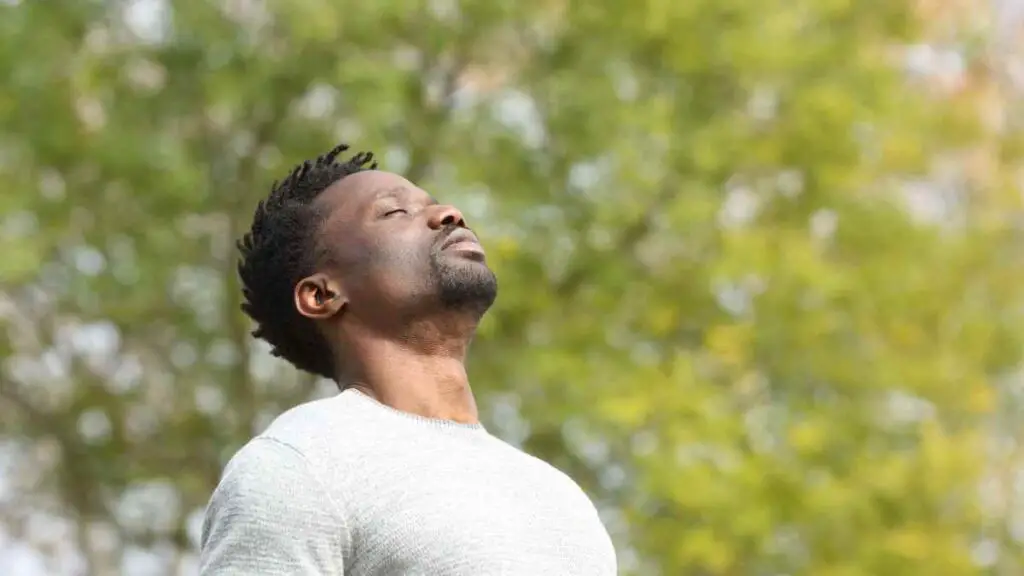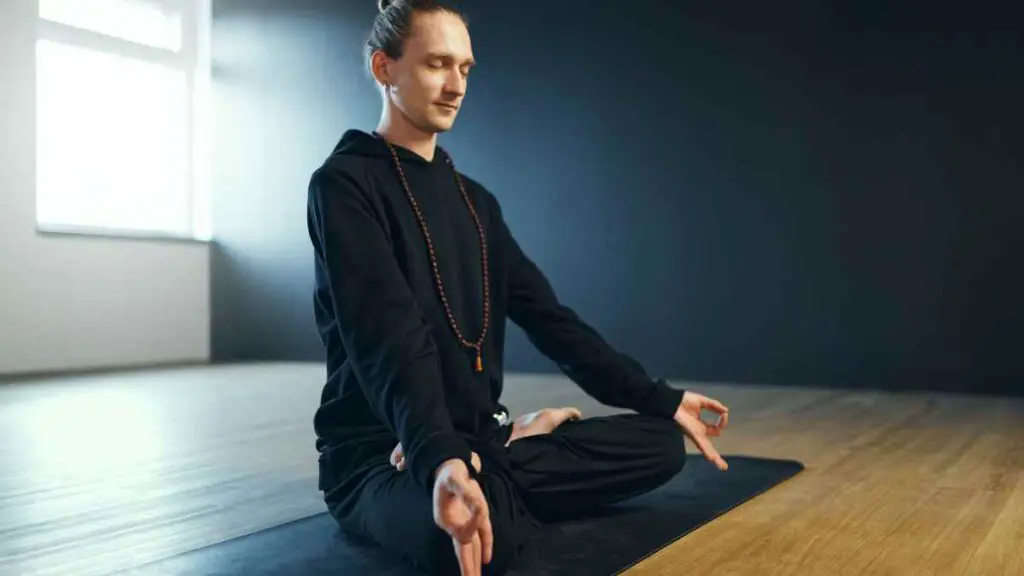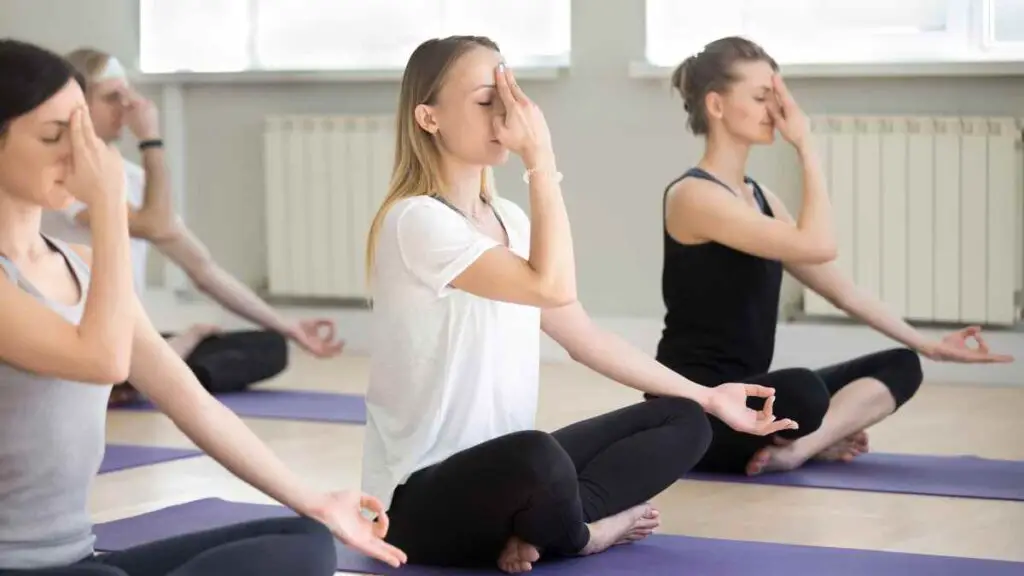Are you feeling stressed and overwhelmed?
Are you looking for a way to relax and reduce your stress levels?
If so, then breathwork for beginners might be just what you need! Breathwork is a powerful and simple practice that can help to reduce stress, improve your mood, and bring more clarity and focus to your life.
This article will explore the basics of breathwork for beginners, so you can start reaping the benefits immediately!
What is Breathwork?

Breathwork involves conscious breathing techniques to improve physical, mental, and emotional well-being. It is a powerful tool that can help us to relax, reduce stress, and increase our energy levels. Breathwork has been used for centuries in many cultures and is now gaining popularity in the Western world.
Breathwork is a safe and natural way to improve our health and well-being and is based on the idea that our breath is the gateway to our inner world. By consciously controlling our breathing, we can access deeper states of consciousness and gain insight into our thoughts, emotions, and physical sensations. This can help us uncover hidden aspects of ourselves and clarify important life issues.
Breathwork can be done in various ways, from simple diaphragmatic breathing to more advanced techniques such as Holotropic Breathwork. Each type of breathwork has unique benefits and can be used for different purposes. For example, some types of breathwork can be used to reduce stress and anxiety, while others can be used to increase energy and focus.
Benefits of Breathwork
The benefits of breathwork are numerous and far-reaching. For starters, it can help to reduce stress and anxiety. This is because when we breathe deeply, it activates the parasympathetic nervous system, which is responsible for calming and relaxation.
By consciously controlling our breathing, we can reduce the stress hormones in our body, which can help to reduce feelings of anxiety and overwhelm.
Breathwork can also help to improve focus and increase energy levels. When we take slow, deep breaths, it helps to oxygenate our cells, which can help us to think more clearly and remain focused. It can also help to reduce fatigue and increase energy levels.
Breathwork can also help to reduce symptoms of depression. Taking slow, deep breaths increases the serotonin levels in our brain, a neurotransmitter responsible for feelings of happiness and well-being. By consciously controlling our breathing, we can increase serotonin levels in our brains, which can help reduce feelings of depression.
Finally, breathwork can help to promote overall health and well-being. Taking slow, deep breaths helps reduce the cortisol levels in our body, a hormone responsible for stress and inflammation. By reducing the levels of cortisol in our body, we can reduce inflammation and promote overall health and well-being.
So, breathwork could be the perfect solution if you’re looking for a way to reduce stress, improve focus, and increase energy levels. It’s a powerful tool with numerous benefits.
Types of Breathwork Techniques

There are many different types of breathwork, each with its unique benefits. Here’s a look at some of the different types of breathwork and what they can do for you.
- Rebirthing Breathwork – This type of breathwork is used to help you access and release deep-seated emotions that may be holding you back. It involves deep, circular breathing meant to bring about a sense of peace and clarity.
- Holotropic Breathwork – This type of breathwork is meant to help you reach a state of consciousness where you can access your inner wisdom and gain insight into your life. It involves deep, rapid breathing and is often accompanied by music, chanting, and movement.
- Pranayama – This type of breathwork is used to help you balance your energy and bring about physical and mental well-being. It involves specific breathing patterns and is often used in yoga and meditation.
- Transformational Breathwork – This breathwork is meant to help you release old patterns and create new ones. It involves deep, conscious breathing and is often used to help people overcome trauma and emotional pain.
Let’s take a closer look at each.
Pranayama

Pranayama is an ancient practice that has been around for centuries and is still practiced today. It is a type of yoga that focuses on the breath and is said to help with relaxation and meditation. Pranayama is often referred to as the “breath of life” and is believed to help bring balance to the body and mind.
The practice of Pranayama involves controlling breathing through various breathing exercises, which can be done sitting, standing, or even lying down.
The goal is to become aware of the breath and be able to control it. This can be done by focusing on the flow of the breath and the rhythm of the inhale and exhale.
Pranayama is said to have many benefits, such as reducing stress and anxiety, improving concentration and focus, and even strengthening the immune system. It can also help to increase energy levels, improve sleep quality, and reduce fatigue.
Holotropic

Holotropic breathwork is a therapy that combines breathing, bodywork, and music to induce a non-ordinary state of consciousness. It is a powerful tool for personal transformation, healing, and growth.
Holotropic breathwork was developed in the 1970s by Stanislav Grof, a psychiatrist and pioneer in transpersonal psychology. He believed that the mind and body are connected and that healing can occur when a person can access the unconscious mind. To do this, he combined elements of Eastern and Western spiritual practices to create a unique approach to therapy.
Holotropic breathwork aims to help individuals access and explore their inner worlds. During a session, participants are guided to breathe in a specific rhythm while listening to music that has been specifically chosen to help them reach a non-ordinary state of consciousness. They are encouraged to explore their inner experience as they breathe, allowing them to access deep levels of their psyche.
The effects of holotropic breathwork can be profound. People often report feeling a sense of peace, clarity, and insight. They may also experience a deep emotional release and physical healing.
Transformational

Imagine a world where you can breathe yourself into a happier, healthier, and more balanced life. Well, that world exists, and it’s called transformational breathwork. It’s a type of breathwork that focuses on using specific breathing patterns to create deep relaxation and release emotional blockages.
Think of it as hitting the reset button on your body and mind. It’s like giving your internal organs a massage, your nervous system a hug, and your brain a power nap simultaneously!
It’s a simple yet powerful practice that anyone can do, regardless of age, fitness level, or experience. All you need is an open mind and a willingness to explore your breath.
Transformational breathwork will help you to release tension from your body, clear your mind, and reduce stress and anxiety. It’s a practice that can help you to improve your physical health, emotional well-being, and spiritual connection.
So, if you’re feeling stuck, stressed, or just plain old tired, give transformational breathwork a try. It’s like a secret weapon for your mind and body!
In short, Transformational breathwork is a fun and easy way to improve your physical and mental well-being. It’s a powerful tool that can help you to release tension, clear your mind, and reduce stress and anxiety. It’s a way to hit the reset button on your body and mind and discover a deeper sense of relaxation, joy, and peace.
Rebirthing

Imagine breathing your way to a new level of self-awareness and personal transformation.
That’s precisely what rebirthing breathwork can do for you.
It involves breathing in a circular and continuous pattern without pausing between inhales and exhales. This creates a sensation of being “reborn” and can help to release deep-seated emotional blockages and traumas.
Think of it like a deep cleaning for your mind and soul. It’s like giving your emotional baggage the boot, saying goodbye to old patterns, and limiting beliefs holding you back.
Rebirthing breathwork can be a powerful tool for personal growth and self-discovery. It can help you to access your inner wisdom and intuition and to connect with your true self. It can also help to improve your physical health, reduce stress and anxiety, and increase your sense of well-being.
So, if you’re stuck in a rut or ready to take your personal growth to the next level, give rebirthing breathwork a try. It’s like a secret weapon for unlocking your full potential.
In short, Rebirthing breathwork is a wild and dynamic way to improve your physical and mental well-being. It’s a powerful tool that can help you to access deep states of consciousness, release emotional blockages, and increase your self-awareness and personal growth.
It’s a way to deeply clean your mind and soul and access your inner wisdom and intuition.
Preparing for Breathwork

Preparing for breathwork can be an exciting and empowering experience. Taking the time to get yourself ready can make the process easier and more enjoyable.
Here are some tips to help you get the most out of your breathwork session.
- Get Comfortable: Before getting started, make sure you are in a comfortable position. Whether you’re sitting in a chair or lying down on the floor, you want to be able to relax and focus on your breath.
- Set the Mood: Create a peaceful atmosphere conducive to relaxation and inner exploration. You can do this by dimming the lights, playing calming music, or burning incense.
- Set an Intention: Before getting started, take a few moments to set an intention for your breathwork session. This could be something like “I am open to the healing power of my breath” or “I am ready to explore my inner world.”
- Focus on the Breath: Once you’re ready, it’s time to focus on your breath. Close your eyes and take slow, deep breaths. Be mindful of the air entering and leaving your body.
- Let Go: As you breathe, let go of any expectations or judgments. Allow yourself to be open and receptive to whatever comes up during your session.
Preparing for breathwork can be a great way to get in touch with your inner self and open yourself up to the healing power of your breath. You can make the most out of your breathwork session and enjoy the journey by getting yourself ready.
Techniques for Breathwork

Breathwork is an amazing practice that can help you to reduce stress, improve your overall well-being, and even help you to reach a higher level of consciousness. But it can be a bit tricky to get the hang of.
Here are some techniques to help you get the most out of your breathwork sessions.
First, focus on your breathing. Start by taking a few deep breaths and then focus on breathing as you exhale. Feel the air moving through your body and out of your nose or mouth. Notice how your body responds to each breath.
Next, try to make your breaths more controlled. This will help you to relax and stay focused on your breath. Take slow, deep breaths, gradually making them longer and more controlled. You can also try to add a few pauses between each breath to help you stay focused.
Finally, use visualization techniques. Visualize a peaceful place or an object that brings you joy, and focus on that as you breathe. This will help keep your mind from wandering and help you to stay in the moment.
Deep Breathing

Deep breathing is like a magical elixir for the body and mind. It can help you relax, reduce stress and anxiety, and even help you sleep better at night. It’s a simple yet powerful tool that can help you feel more energized, balanced, and connected to yourself.
When you take a deep breath, you tell your body that it is time to relax. As you inhale, you fill your lungs with oxygen, which helps to increase your energy and alertness. As you exhale, you release tension and stress, allowing your body to relax and your mind to be calm.
When you practice deep breathing regularly, you can begin to notice its positive effects on your body and mind. Your breathing becomes more relaxed, and your body more relaxed. As a result, you may feel more energized and alert, with an overall sense of well-being.
Deep breathing can also help to reduce stress and anxiety. Taking a deep breath signals your brain that it is time to relax. This can help to reduce the physical and mental symptoms of anxiety and stress.
Finally, deep breathing can help you to get a better night’s sleep. When you take deep breaths, your body relaxes, and your mind can drift into a peaceful sleep.
Deep breathing is a simple and powerful tool that can help you to relax, reduce stress and anxiety, and get a better night’s sleep. So take a few minutes each day to practice deep breathing and enjoy its many benefits.
Ujjayi Breath

Ujjayi breath is a powerful breathing technique that’s been used for centuries in yoga and meditation. It’s a simple and effective way to bring more awareness and relaxation to your practice.
Ujjayi breath is often called “ocean breath” because of its sound. To practice it, you inhale and exhale through your nose while constricting the back of your throat. This creates a soft, low sound similar to the sound of the ocean.
The benefits of Ujjayi breath are numerous. It increases oxygen flow to the body, helps to reduce stress and anxiety, and can even help to improve your focus and concentration. It also helps to regulate your breath, which can help to increase your energy and vitality.
Ujjayi breath can be used in almost any yoga pose, from standing to seated poses to inversions. It can be used to help you stay in a pose for a longer period and to help you find a deeper level of relaxation.
So, if you’re looking for a simple and effective way to bring more awareness and relaxation to your practice, give Ujjayi breath a try. With a little practice, you’ll soon be breathing like an ocean!
Alternate Nostril Breathing

Alternate nostril breathing is an ancient yogic practice that can help to soothe the mind and body. It’s simple, and the benefits can be felt immediately.
First, find a comfortable seated position and take a few moments to relax and become aware of your breath. Next, bring your right hand to your nose and use your thumb and ring finger to block off the right nostril. Take a deep breath through your left nostril, switch and block off the left nostril with your thumb and exhale through the right nostril.
Continue to alternate nostrils, inhaling and exhaling through each one in turn. You can keep your eyes closed and focus on the sensation of the breath as it travels in and out of the nostrils.
As you practice, you may notice that the breath begins to slow and deepen. This is a sign that the body is beginning to relax and the mind is calming. You may also feel a sense of balance and clarity as the body’s energy becomes more balanced.
Alternate nostril breathing is a great way to reduce stress and anxiety and improve concentration and focus.
Kapalabhati Breath

Kapalabhati breath is a type of yoga breathing that can help you to get your day off to a great start! It’s a powerful breathing technique that increases your energy, improves your concentration, and helps to detoxify your body.
Kapalabhati breath is also known as “skull-shining breath” because it’s believed to help you to clear away any mental fog and bring clarity to your mind. It’s a great way to start your yoga practice or your day.
To practice Kapalabhati breath, you’ll need to sit comfortably with your spine straight. Begin by taking a few deep breaths and then rapidly exhale through your nose, contracting your stomach muscles. You’ll want to do this in a rhythmic pattern, inhaling and exhaling quickly.
The key to getting the most out of Kapalabhati breath is to focus on your breath. As you practice this technique, you’ll want to keep your mind clear and concentrate on breathing.
Kapalabhati breath can be a great way to start your day. It can help you energize your body and mind and prepare for whatever the day brings. Give it a try and see how it can help you to become more focused and energized.
Bhastrika Breath

This ancient breathing exercise is like fresh air in the modern world. It’s a simple yet powerful way to improve physical and mental health, and it’s been around for centuries.
Bhastrika Breath, also known as “Bellows Breath,” is a type of Pranayama (yogic breathing) that involves taking short, powerful breaths. It’s said to be one of the most effective breathing techniques, as it can help to reduce stress and anxiety, improve focus and concentration, and even increase energy levels.
The benefits of Bhastrika Breath don’t stop there. It can also help to improve cardiovascular health, strengthen the lungs, and even reduce the risk of respiratory illnesses. It’s even been known to help with digestion, increasing oxygen flow to the digestive organs.
So, how do you practice Bhastrika Breath? It’s pretty simple! All you need to do is sit comfortably, close your eyes, and take deep breaths. Then, begin to take short, powerful breaths and exhale fully. As you do this, focus on your breath and the sensations in your body.
Bhastrika Breath is a great way to improve your overall well-being. Give it a try and see how it works for you!
Nadi Shodhana

Nadi Shodhana is a breathing technique often referred to as “alternate nostril breathing.” It has been an ancient yogic practice to promote balance, clarity, and peace of mind for centuries. The practice involves inhaling and exhaling through alternate nostrils to balance energy flow throughout the body.
Nadi Shodhana is a simple yet powerful technique that can reduce stress, improve concentration, and increase overall well-being. The practice is often used as a form of relaxation and can be done anywhere, anytime. It can be done sitting or lying down; it only takes a few minutes to complete.
The technique begins with a deep inhalation and exhalation through both nostrils. Then, the left nostril is blocked off with the thumb, and the right nostril is used to inhale and exhale. After a few breaths, the thumb is moved to the right nostril, and the left nostril is used to inhale and exhale. This process is repeated several times until the breath is even and balanced.
Nadi Shodhana is an excellent way to relax and clear the mind. It can also help reduce stress, improve focus, and increase energy levels. It is a great practice for anyone looking to bring more balance and clarity into their life. So why not try it and see what a difference it can make?
Conclusion
Breathwork can be a powerful tool for anyone, no matter their experience level.
With practice and dedication, you can unlock this ancient practice’s full potential and reap its many benefits.
So, take a deep breath, and start your spiritual journey into the world of breathwork today!
And don’t forget to leave a comment below to let us know how your journey is going!



